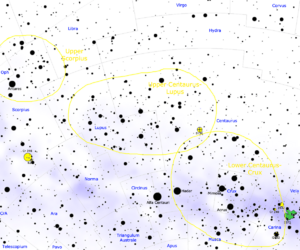Scorpius–Centaurus Association facts for kids
The Scorpius–Centaurus Association, often called Sco–Cen, is a large group of stars found close to our Sun. These stars are very far away, about 380 to 470 light years from us.
All the stars in Sco–Cen are quite young. They formed from the same giant cloud of gas and dust. Most of these stars are between 11 and 15 million years old. This group includes famous stars like the huge Antares and many of the bright stars you see in the Southern Cross.
Contents
What is the Scorpius–Centaurus Association?
The Sco–Cen group is a big part of an area where new stars are still forming. This process has been happening for less than 20 million years. Around Sco–Cen, there are several large clouds of gas and dust where stars are being born right now.
How Do These Stars Move?
The stars in the Sco–Cen association all move in almost the same direction. They travel at about 20 kilometers per second compared to our Sun. The stars within the group move very similarly, with only small differences in speed. Because of this, the group is probably not held together by gravity anymore.
Supernovae and Bubbles in Space
Over the last 15 million years, several giant star explosions, called supernovae, have happened in the Sco–Cen group. When a massive star explodes, it sends out a lot of gas and energy. These explosions have created huge, expanding gas bubbles around the group, known as superbubbles.
Evidence from Earth's Ocean Floor
Scientists have found something interesting in sediments on the sea floor. They found a special type of iron called Iron-60. This type of iron is usually made when a supernova explodes.
Finding Iron-60 in old fossilised bacteria suggests that a supernova exploded near our Solar System about 2 million years ago. More Iron-60 has also been found in sediments that are 8 million years old. This tells us that supernovae from the Sco–Cen association might have affected our part of space a long time ago.
Images for kids
-
Main associations of the Solar antapex half of the galactic plane, with Sco-Cen on the left
-
Close up on the Orion Arm, with major stellar associations (yellow), nebulae (red) and dark nebulae (grey) coreward from the Local Bubble with Sco-Cen.
See also
 In Spanish: Asociación estelar de Scorpius-Centaurus para niños
In Spanish: Asociación estelar de Scorpius-Centaurus para niños



